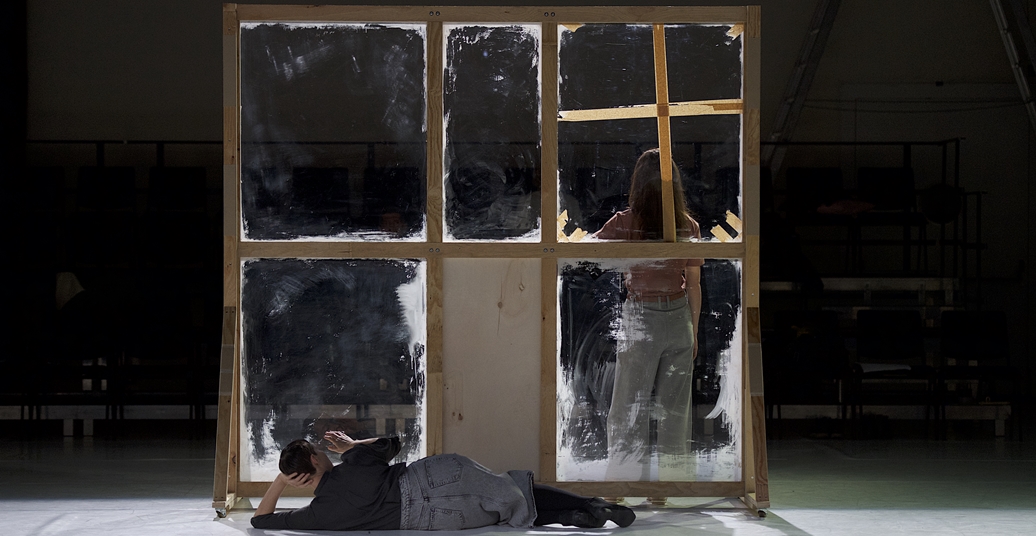Sandwiched between ascending tribunes, the stage is open and white. Large, wooden slabs are lying flat on the ground like abandoned kids’ bicycles, ready to be picked up and ridden at will. One performer, female, dressed in dark, everyday clothes, flips a chair upright and takes a seat. Three other performers are scattered across the space, as if they have landed in their positions by the roll of a dice. The tension in the room is tangible as all eyes are directed towards her.
With her first line, she addresses another performer, male, blond, standing to her right. He responds, his body mimicking the actions of a bartender. He produces a drink from an imaginary tap and the immaterial architecture of the space-within-the-space becomes visible as he leans, elegantly, on the counter. Their dialogue is swift, conjuring images of a late night encounter between strangers. Later, the seductive atmosphere is enhanced as the air becomes heavy with wisps of smoke from a cigarette. Scintillated, I can grasp the feel of their elusive world, which seems oddly displaced as it unravels on the open, white canvas of Hanna Hegenscheidt, Uli Huhn, and Chris Gylee’s collaboration “Not Good Alone”.
This exchange between strangers is also the opening scene of Fassbinder’s 1974 film “Angst essen Seele auf”. But in contrast to the order of events in the film, the scene disintegrates rapidly, dissolving into a new constellation. The cards are reshuffled and the performers find themselves in new positions, sampling other moments. With their words and movements, they channel the characters of the film, revisiting and relocating their dialogues and relationships. It reminds me of exploratory surgery, in which the organism is placed under tight scrutiny, by means of the meticulous dissection of its organs.
Chris Gylee’s set design, too, seems to function like an organ. One by one, the performers lift the wooden slabs, like hoisting the sails of a ship, adapting their height according to the changing winds. Various settings materialise: from their starting position as a jagged non-shape, the elements are reorganised into a line that slices the stage in half, and later are clustered into two islands. The walls are solid yet transparent (because of the windows) and permeable (because of the door). The performers follow what the set suggests, moving in and out of the newly formed areas, activating the floating structures with cinematic urgency.
This is enticing: the infinite possibilities of recombination give a sense of timelessness. At times the pace picks up and noises and voices ring out all at once. These sudden surges of energy climb towards a peak – but the climax is never reached. It turns out to be just a minor hill, a short curve, a tantalising suggestion: it leaves me hanging, lingering in confusion. The repetition allows me to make links and become familiar with the material, but its underlying pattern remains undetectable. I balance, somewhat awkwardly, between frustration and awe.
The re-performance of the film clips has a universal appeal. The actions are simple: the performers have drinks, they wander around their houses, they sit on chairs or collapse on the floor. Upon repeating and fragmenting these everyday gestures, their complexity is revealed. And the moments of sensitivity that spring from this landscape of detachment, are ever more striking in their honesty. The English, the German and the bad German intermingle. Hegenscheidt’s choreography leaves room for reflection, and points towards an expansiveness beyond the here and now. It is carried, with care and restraint, by this multi-angled Fassbinder playlist.




